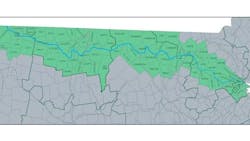MassDOT releases final report on Northern Tier Passenger Rail Study
The Massachusetts Department of Transportation (MassDOT) has released the final report on the Northern Tier Passenger Rail Study, which examined the benefits, costs and investments necessary to implement passenger rail service from North Adams to Greenfield and Boston, with the speed, frequency and reliability necessary to be a competitive option for travel along the corridor.
“MassDOT is proud to announce the release of the Northern Tier Passenger Rail Study final report, which examines passenger rail service alternatives between North Adams, Greenfield and Boston,” said MassDOT Secretary and CEO Monica Tibbits-Nutt. “Regional connectivity between west and east is a key priority as we imagine the future of transportation in Massachusetts. The Northern Tier Passenger Rail Study will be a valuable planning tool to identify service alternatives that can expand rail access, reduce congestion and connect communities statewide.”
The conceptual planning study developed and assessed six options for rail service along the corridor. According to MassDOT, there were three overarching goals for the study:
- Support economic development along the Northern Tier corridor.
- Promote transportation equity.
- Minimize impacts on public health and the environment from transportation.
MassDOT notes public participation was critical in refining the study’s goals and objectives, evaluation criteria and the alternatives development process. The public involvement process included four meetings with the stakeholder working group consisting of federal, state, regional and local representatives, three public information meetings and a public workshop.
According to MassDOT, potential routes were developed and evaluated based on the established goals, objectives and evaluation criteria, as well as identified challenges and opportunities. The process began with the development and evaluation of two potential routes representing lower investment and higher investment scenarios. With feedback from the working group and the public, the two initial routes were refined and four additional routes were developed and assessed as part of phase 2.
MassDOT notes each option provided improved connectivity, mobility and transportation choice in the Northern Tier corridor, with Alternative 3 (electrified service) and Alternative 4 (full local service) achieving the highest ridership levels of the six potential routes.
The study found that while the fundamental scale of ridership and cost is established, more work would be needed to further develop the markets, ridership, costs and benefits from a transportation planning perspective. The study revealed a complex set of opportunities and challenges with three key conclusions:
- Based on current demographic and economic trends, much of the projected ridership is concentrated east of Fitchburg, Mass.
- Due to the timeline for implementing any passenger rail service corridor, mobility improvements should be explored that could provide connectivity in the shorter term. Coordinated regional and municipal planning to support rail service implementation should be undertaken.
- The rail along the Northern Tier corridor is a strategic asset for the entire commonwealth and should be treated as such. Given the competitive options for freight service that the route offers, the societal and environmental benefits of freight rail, as well as utility for mitigating increasing climate risks, ensuring a long-term future for the route is warranted.
Recommended next steps
- Continue to improve understanding of travel demand along the Northern Tier corridor, corridor segments and linkages to key regional destinations: The analysis identified two important gaps, including key drivers of travel demand in the corridor and the New York City travel market to northern Berkshire County. More granular and current Northern Tier travel data, including any COVID-19 pandemic-induced changes, would be beneficial. The study noted this could include a closer examination of traffic associated with communities in Vermont and New Hampshire and with area academic institutions. Understanding the Albany, N.Y., market could affect the potential for the western section of the Northern Tier.
- Advance planning efforts at the intersection of economic development needs and opportunities and serving travel demand: The creation of a coordinated economic development strategy for the central and western sections of the Northern Tier would provide a platform to realize sustainable economic growth in the region by leveraging investment in intercity public transportation.
- Explore scheduled motor coach service to Northern Tier corridor destinations: Motor coach service can be a relatively low cost means of improving mobility and developing demand for any future rail service.
- Evaluate alternative phasing or implementation strategies: Most of the Northern Tier corridor is served by regional transit authorities, with a focus on serving the needs of their immediate service area. In May 2024, MassDOT awarded a Regional Transit Innovation Grant (RTIG) to a joint effort by Berkshire Regional Transit Authority (BRTA), Pioneer Valley Transit Authority (PVTA) and Franklin Regional Transit Authority (FRTA). The RTIG aims to rehabilitate seven buses and operate a commuter bus network to increase regional connectivity between BRTA, PVTA and FRTA. Such enhancements and further coordination among these services would improve intra-corridor mobility and connectivity while also offering the potential for improved efficiency.
- Evaluate express service between Fitchburg and Boston: Implementation of express service between Fitchburg and Boston could offer a relatively low-cost option to initiate upgraded public transportation and perhaps open access to other sources of capital funding for projects such as eliminating the single-track operation through Waltham.
- Monitor corridor freight use and trends to explore needs/opportunities for public investment: Federal grant funding offers potential opportunities to advance improvements along the Pan Am Southern corridor, including needed potential projects such as Hoosac Tunnel renewal, bridge strengthening, clearance projects to allow double-stack service, Ayer intermodal terminal improvements and investments that may mitigate severe damage from flooding caused by climate change. Underlying such an effort will be close coordination with Pan Am Southern ownership and in the context of a coordinated strategy for rail system improvements on the two east west main lines.
- Develop strategies for improving rail connections within the corridor to support economic development, transportation equity and minimizing impacts to public health/environment: A successful strategy to develop a Northern Tier passenger rail service would require all of these entities and groups to communicate and coordinate effectively, as funding and permitting entities look for unified support for projects. Host railroads and operators apply their resources and efforts to projects with credible strategies and plans.
The study notes federal funding would be necessary to meet the recommendations. Policy decisions and strategy are the required next steps to determine if and how the commonwealth will proceed. The existing Compass Rail plan anticipates enhancing connectivity and transportation equity across the commonwealth. The connection between Greenfield, Springfield and Boston is in the implementation stages and could be a mechanism to achieve increased west-east mobility.
About the Author
Brandon Lewis
Associate Editor
Brandon Lewis is a recent graduate of Kent State University with a bachelor’s degree in journalism. Lewis is a former freelance editorial assistant at Vehicle Service Pros in Endeavor Business Media’s Vehicle Repair Group. Lewis brings his knowledge of web managing, copyediting and SEO practices to Mass Transit Magazine as an associate editor. He is also a co-host of the Infrastructure Technology Podcast.

